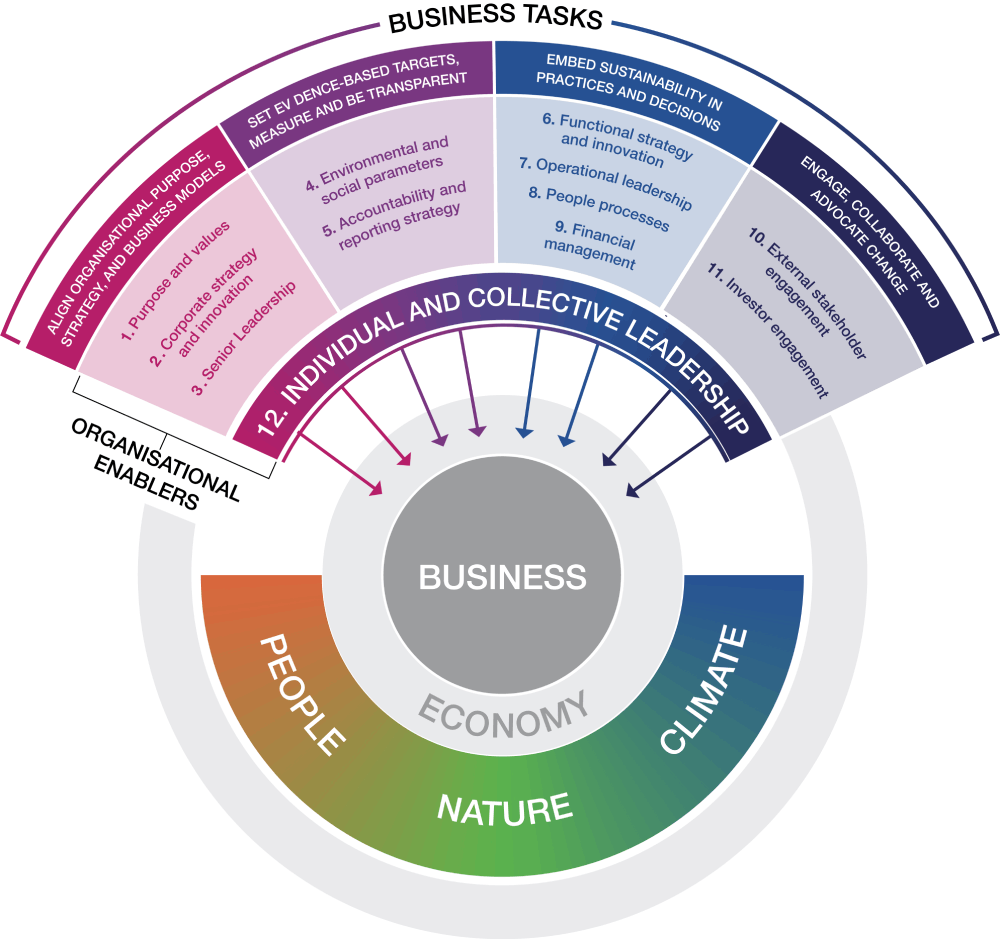
25 October 2023 - Ben Kellard, CISL's Director of Business Strategy, discusses the issues that businesses face when trying to become more sustainable and introduces the Business Transformation Framework.
Why should business care about sustainability issues? This is the question explored in a recent CISL blog, ‘The business case for sustainability’. It explores the many reasons that businesses should want to become more sustainable, to embed resilience and efficiency into their practices, optimise their brand and reputation and address future financial risks.
Across the past two years, CISL has published its ‘Unleashing the Sustainable Business’ papers, which examine an alternative approach to business that creates durable, equitable wellbeing. This research argues that Business as Usual (BaU) undermines sustainability and that the only way to deliver a sustainable future is through business transformation which can be enabled through a sustainable purpose.
A recent survey of 1,000 CEOs indicates that, over the past five years, organisational purpose has gone from being largely overlooked, to being recognised for its ability to drive more strategic and connected business value. Our own research shows that the discussion around purpose is also reaching the boardroom, and some boards are even holding the executive to account for its integration. If the risks of BaU are high and the opportunities are clear, why aren’t more businesses transforming? Interestingly, 89% of the CEOs had a purpose; however, their biggest challenge was making it actionable and relevant.
These findings reflect the leaders we work with. They are becoming increasingly aware of the need to significantly transform their business to be more sustainable, relevant and resilient. However, they aren’t clear on how they should go about it. It’s what I call ‘the how gap’. There are several of common barriers they face:
- Overwhelm – by both the uncertainty and complexity of how short and long term trends converge to impact across their value chain and what risks and opportunities might result from them;
- What good looks like – for their organisation’s future and business leadership in general, so it’s hard to know where they are starting from, and where they want to get to and if it goes far enough;
- Navigating nascent markets and regulatory failures – many sustainable solutions (such as alternatives to single-use plastics) are either at an early stage or lack the investment or regulation to scale them up,
- Busyness – as businesses have to react to immediate pressures, it’s hard to find the time to address complex, unfamiliar knotty challenges;
- Influence – while they know they can’t deliver new sustainable value propositions on their own, they don’t know who to influence or collaborate with, how, why or when;
- Where to start – these combined make it hard to know what ‘levers’ to pull and in what sequence to navigate the transformation and uncertainty.
So, how can leaders navigate these challenges and capture the latent opportunities for their organisations?
The Business Transformation Framework
CISL has developed the Business Transformation Framework (BTF) to help businesses understand their current performance across 12 organisational enablers, that represent the aspects of a business that drive internal and external business transformation. These enablers are summarised below.
The BTF then sets out what evidence you would see for each enabler, across four 'types' of business responses to BaU. These types, range from short-term self-interest to purpose-driven, that represents leadership. This allows businesses to locate their current leadership performance and inform their future aspirations and plans.
You can view the full framework here.
The framework was developed alongside leading businesses to ensure it was stretching, practical and relevant and it drew on our Unleashing the Sustainable Business reports and PAS 808 to ensure it reflected the evidence for what a leading sustainable business looks like.
Most environmental, social, and governance (ESG) and sustainability indices focus on the what (such as carbon) and less on the how. The BTF also seeks to address this gap by highlighting both the enablers of transformation and what good looks like for them. By setting out what you would see for each of the maturity levels against each of the 12 organisational enablers, businesses can use the framework in a number of ways:
- Locate current performance – across the 12 enablers by assessing which of the four business responses best describes their organisation. This enables a shared view of current performance against a robust leadership framework that distinguishes performance between the enablers.
- Inform future aspirations – the evidence for the four types can inform the business’ future aspirations, ranging from revising its purpose and strategy to how effectively the existing one is implemented, across the twelve enablers.
- Gap analysis – that highlights the gap between the current performance and future aspirations for each of the 12 enablers against the four types.
- Inform business transformation journey – the gap analysis can allow the business to prioritise the enablers it wants to focus on, then sequence the dependencies between them, to form the basis of a transformation programme. It can also suggest what the next step might look like for each prioritised enabler based on the description for the next type of business response.
For example, a gap analysis may reveal that the business has a strong purpose and has integrated it into strategy and functional strategies but needs to prioritise integrating it further into people processes and engage external stakeholders more strategically.
While there is still a lot for business leaders to do to navigate and shape the rapidly changing external context, we hope that the BTF will become a powerful tool for them as they seek to close the ‘how’ gap and realise the full potential of their organisations. For more guidance on what business transformation looks like, in theory and practice, and what it looks like in action for nature, climate and people, please see our Business Transformation hub. We hope the framework both inspires and guides you on your transformation journey.






